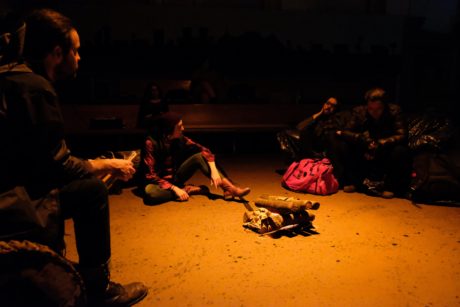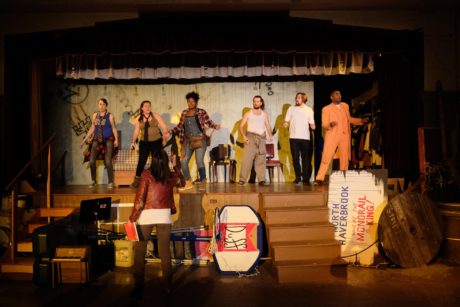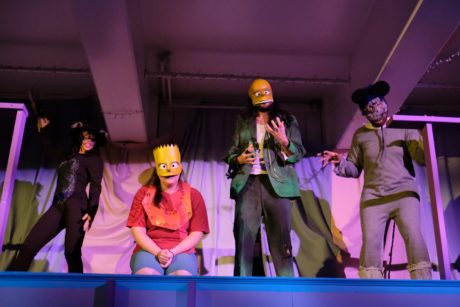What better venue for a production of Anne Washburn’s Mr. Burns, a Post-Electric Play – an ensemble piece set in a dystopian future where the power grid has failed, sending all our nuclear power plants into meltdown – than a fallout shelter? Specifically, The Fallout Shelter at United Evangelical Church, perhaps better known in Baltimore theater circles as the home of Cohesion Theater Company.
Mr. Burns, Cohesion’s second offering of their fourth season, is presented in three acts, each representing a different time period after the fall of civilization. Between the acts are brief intermissions, signaled by a recorded announcement instructing audience members to evacuate their seats and proceed to the museum and concessions stand. They’re not kidding; get up and move to the back of the venue. Not unlike the TARDIS, Mr. Burns travels through both time and space. Audience seating is reconfigured each act to offer optimal viewing of the action, which occurs in three different areas in The Fallout Shelter. While you’re up, do check out the museum – a wonderful collection of Simpsons artifacts curated by Cohesion Director of Artistic and Community Engagement, Caitlin Carbone.

Act I: A Few Days from Now
As the play opens, a small group of people is gathered around a fire. The theater is dark, save for a flickering orange bulb centered high above the campfire, simulating firelight, the first of many inspired choices by Lighting Designer Daniel Weissglass. It’s not long after a catastrophic series of events that has left the world in darkness; electricity exists only in memory and cascading nuclear reactor failures have killed millions and sickened more. The group – Matt (Jonathan Jacobs), Jenny (Hannah Fogler), Maria (Meghan Stanton) and Sam (Christine Wells) – were, until recently, strangers. A fifth person, Chara Bauer, is also present, silent and just beyond the firelight. The fireside group is discussing, of all things, The Simpsons, the longest running scripted television show in U.S. history. Specifically, they are recounting the plot and dialogue of fan-favorite episode, “Cape Feare.” Jacobs’ character, Matt, is the biggest Simpsons fan and, thus, is leading the conversation. Jacobs’ impressions of the various members of the fictional Springfield community are spot-on.
With the arrival of an outsider, talk stops and defenses raise. After discerning he is not a threat, merely a fellow traveler, the group welcomes Gibson (Matt Casella). In what I found to be the most distressingly realistic scene of the show, Gibson reports in about the state of the places he has traveled and the group inquires about loved ones he may have encountered. In the post-internet world, there is no FaceBook Safety Check where people can alert family and friends that they are okay despite a disaster in their area. Absent electricity and mass communication, there are simply lists of names.
The first act may be my favorite part of Mr. Burns. The fireside chat introduces relatable characters I quickly invested in. Ultra-realistic dialogue is the result of a novel development and workshopping process used by Playwright Anne Washburn, in which she recorded a group of people (IRL named Matt, Jenny, Maria, Sam, and Gibson) trying to collectively remember a full Simpsons episode over the course of a week. Act I includes, verbatim, parts of those discussions. Each actor in this scene delivers a strong, natural performance, but Meghan Stanton deserves special recognition. Her portrayal of Maria was so organic and genuine, it prompted one of my companions to ask Director Lance Bankerd if Stanton’s performance had been improv (she was told no, every stammer and um was in the script). Impressive.

Act II: Seven Years from Now
In Act II, we see this same group of survivors, plus a few new additions, seven years later. They have formed an itinerant theater troupe whose most popular play is, you guessed it, the “Cape Feare” episode of The Simpsons. There is a lot of competition among Simpsons-producing traveling theater companies; this troupe’s secret weapon is their commercials. Watching this group rehearse is wonderful. Chara Bauer is hilarious as the exasperated director, Colleen. Nicholas Miles is entirely delightful as Quincy, especially in a commercial that is a food porn extravaganza featuring references to a cornucopia of no-longer-available delights.
The best commercial, though, is called Chart Toppers, a mashup of big hits from before everything changed. The ensemble sounds great; I was particularly wowed by Christine Wells, who plays Sam, and Meghan Stanton, as Maria. (How have I seen Stanton in so many shows and never before known what an amazing voice she has?) As in the first act, there is a silent member of the community, in this instance played by Kate Hughes, keeping to the shadows and edges of the action.

Act III: Seventy-Five Years After That
Seventy-five years after the close of Act II, there is no one still around who remembers a world with electricity. The Simpsons, once freshly recalled around the campfire as an entertaining diversion, has become a thing of myth. A version of the “Cape Feare” episode has survived, mythologized over time into an allegory of the dark, post-apocalyptic days of man. As Joseph Campbell once said, “A ritual is the enactment of a myth.” And a ritual act is what “Cape Feare” has become.
The third act is a stylized opera, the actors in skillfully-created masks depicting characters from the once-animated sitcom. But this is more Greek tragedy than comedy. The ritual performance includes musical styles ranging from Gregorian chants to hip hop and utilizes several arcane instruments from our time. Showcasing the singing skills of the cast, Act III provides great solos to Matt Casella and Meghan Stanton, as well as an extended duet with Christine Wells and Hannah Folger, whose voices are moving and beautiful.
A top-notch production team has created a perfect environment for these fine actors and singers to shine. Scenic Designer Jessica Rassp essentially made three sets for this show and each was terrific. Particularly good in Act II, Rassp created a space densely packed with a crazy collection of remnants from a past life, the types of things a seven-year-post-apocalypse theater company might have around them: racks of clothes, a menorah, a basketball hoop, an American flag. She also cleverly designed the play-within-the-play. My favorite bit was the Simpson’s car from the opening credits, ingeniously made from plastic storage tubs. Costume Designer Deana Brill worked the same kind of magic with the clothes and play-within-the-play costumes. From Nicholas Miles’ fabulous orange suit to emblematic Simpsons garb like Lisa’s dress and Marge’s hair – all made from found items – Brill’s inventive costumes were great.
I love the holidays as much as the next guy, but with the Baltimore-DC area producing more than 15 A Christmas Carols and a heaping handful of A Wonderful Lifes, I found this chillingly plausible post-apocalyptic play a welcome change of pace. You’ll have numerous chances to get your holly jolly on this month. Take this opportunity to see something different.
Mr. Burns, a Post-Electric Play is not only entertaining, it also provides engrossing on-the-drive-home conversation topics ranging from the enduring nature of stories to the perils of ignoring pending disasters like climate chaos and the unchecked mismanagement of resources. And Cohesion’s production has everything you could ask for. It boasts a cast of outstanding actors who are, additionally, damn fine singers; gifted direction; innovative costuming, sound, and lighting design; and a meticulously-imagined set.
Don’t make me release the hounds. Go see it.
Running Time: Approximately two hours, with two intermissions.
Mr. Burns, a Post-Electric Play plays through December 17, 2017 at Cohesion Theatre, performing at The Fallout Shelter at United Evangelical Church – 923 S. East Avenue, in Baltimore, MD. Tickets can be purchased at the box office or online.
Note: A special industry night performance will be held Monday, December 11th at 8 pm, at which tickets for all artists will be $10.





